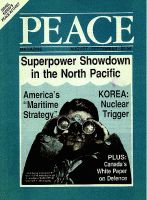
Peace Magazine Aug-Sep 1987, page 32. Some rights reserved.
Search for other articles by Peter Armitage here
In the West, news production and dissemination is a business. As such, success depends on the response of audiences to the "products." Viewers and readers judge these products individually as "consumers," and not as an organized group. That makes it hard to reform the news industry so that activists can alert the public to the true facts of militarization, underdevelopment, and the ecological crisis. Many attempts have been made to organize audiences and empower them to demand changes. These have been ineffective for the most part, except in groups that have undergone radical transformation as a result of a revolutionary change in values.
On the other hand, the media managers do watch their audiences. They do want to "give people what they want" -- so long as it makes money. That fact may make possible an innovation in news reporting, if we can show that audiences would prefer it to the kind of reports now given. This innovation involves the use of alternative news indices.
Halfway through the newscasts, the standard indices come on. Colorful graphics tell you how the Toronto Stock Exchange did today. Moments later, you learn about the Dow Jones. Before you have time to absorb that, you get the currency exchange rate between American and Canadian dollar. Another flash tells you today's gold price.
You get these standard news indices (SNIs) every weekday, twelve months a year. They are the most regular feature of news shows. Are broadcasters giving people what they want? How many people are interested in the stock market?
If you do some research, you find that stockholders, who presumably are the most likely to care about the standard news indices, are a small minority. According to a 1984 study by the Toronto Stock Exchange, only 9.4 percent of the adult Canadian population own shares. Stockholders are mainly males between the ages of 35 and 44, with a larger income than the rest of us. They are well educated and live predominantly in cities in Central Canada, B.C. and Alberta. Nearly half of them reside in Ontario. At most a tenth of adult Canadians are concerned with indices of daily market fluctuations. And not all investors use such reports to make their decisions. TV indices are not specific enough to be useful for investors, who are far more likely to read, say, the Globe and Mail's "Report on Business."
Yet we continue to get such news indices. What would Canadians be more interested in hearing about instead?
Polls consistently show that Canadians are most concerned about unemployment, nuclear war, international peace, and the survival of our environment. News indices on these issues are not, however, routinely shown on TV newscasts.
A research group at Carleton University has set out to produce such alternative news indices (ANIs) and to offer them as an Information subsidy to the media.
The top ranking of these is a Nuclear War index According to statistics from Ruth Lager Sivard's World Military and Social Expenditures, global military expenditures are about to reach $900 billion U.S.) per year, or $1.7 million a minute. At the current rate of the arms race, every member of the human race has to give up an average of three to four years of work to pay for arms spending. Clearly there is a need for ANIs to make this information available regularly.
Statistics available from the National Council of Welfare demonstrate that poverty has clearly been on the rise in the 1980s. A Wealth Disparity index can show the dramatic extent of this. The Canadian Council for Social Development calculates that over four million Canadians live below the poverty line, an increase of almost one million people in the last five years. One in five children and over one million families live in poverty in this country.
As the number of homeless people continues to grow, particularly in large urban centres, a Homeless Canadians index could place this figure in relation to the portion of the government's budget allotted to low-budget housing. Even more pointed in displaying the structure of our social wealth would he a Wage Disparity Index. This index reveals the increasing gap between those wages paid to men and those earned by females in a number of occupations. As well, the wage disparities of the different social classes could also be presented through ANIs.
Statistically more challenging would be an Underemployment Index to quantify the number of Canadians who are locked into jobs which do not allow them to reach their full working potential. A Structural Unemployment index (calculating the percentage of Canadians out of work for over three months) could show the rigidity of the labor market.
There exists a vast potential for indices concerned with the environment and damage being inflicted on it by humankind ANIs dealing with acid rain, soil erosion, deforestation, global population growth, declining food and fuel production, climatic change, plant and animal extinction, and contamination of the atmosphere, would be welcome additions. The long-term prospects for life on this planet would become a topic of regular discussion through ANIs.
Declining food and fuel production may eventually make the earth less habitable for future generations unless preventive action is undertaken. A Global Starvation Index and an Environmental Damage Index can address such concerns.
Plans are underway for developing these indices. A national coalition on alternative information will hold a conference to decide on the specific indices. For more information, contact The Centre for Communication, Culture, and Society, Carleton University, Ottawa K1S 5B6.

Peace Magazine Aug-Sep 1987, page 32. Some rights reserved.
Search for other articles by Peter Armitage here